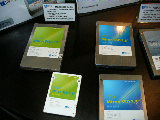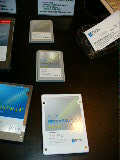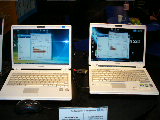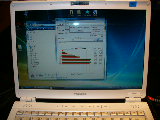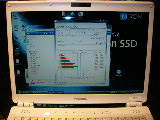 With ultra fast hard disk drives now available, is the asking price for SSD technology justified?
With ultra fast hard disk drives now available, is the asking price for SSD technology justified?
We report on the Solid State Drive market and Mtron’s presence at CeBIT, one of the major players in this market as well as head to head benchmarks of SSD versus HDD.
CeBIT Australia 2008 Special Report
Introduction
Over the last few years thanks to a number of technical innovations such as the reduction of die sizes (the actual size of a integrated circuit) and ongoing evolution- the major semiconductor vendors in the electronics and computing industries have been able to produce Flash RAM in such high densities such as up to 32GB that these high storage capacity devices have changed the way we store our digital media and files.
A by-product of this evolution in flash memory density has been storage vendors have been able to finally develop solid state drives in popular form factors with large enough capacities that can finally replace and surpass desktop and mass-market hard disk drives.
At time of going to press the largest mass produced Solid State Drives utilising NAND Flash RAM technology are 256 Gigabyte offerings, which for the mobile computing segment are a direct match for some of the largest 2.5” Hard disk drives.
NAND refers to the internal architecture of the memory chips, that are used in devices that utilise ‘flash memory’ such as USB sticks, Digital Camera cards, Solid State drives or a large number of other devices such as mobile phones, broadband routers, televisions or anything else which lists some sort of internal storage within the device. Storage products which use NAND flash components now rival and exceed DVDs in capacity and speed.
Solid state drives are not a new concept, and like the optical disc have existed for almost thirty years now but adoption by new markets or users has been hampered by technology constraints.
Once the domain of scientific, industrial or military applications who mainly required speed over capacity, mass market users who will appreciate the ‘plug in’ speed boost to their existing desktop computer, laptop or server.
The small capacity of the memory cells in early devices and large form factors was no problem for early adopters who typically required performance and ruggedness rather than capacity, noting that old HDDs were quite bulky also. At this time it was not deemed a going-forward technology for mainstream or enterprise computing.
It wasn’t until the introduction of the PC card for notebooks by the PCMCIA association in the early 90s that the concept of solid state disk storage in mainstream and portable computing became a practical application.
Some of the early PCMCIA products were indeed flash based disk cards preloaded with operating systems or applications.
During this era however, hard disks and their manufacturers were in boom times which lasted until the early 2000s where there was massive restructuring in the hard disk market which resulted in only a handful of vendors having market share when the dust settled.
Fast forwarding to 2007/2008, we now have a race or war between a large number of niche vendors, start-ups, storage companies, second and third party manufactures and the mainstream semiconductor companies each fighting for a piece of the action, being growing demand for Solid state devices.
Since storage density per memory component has caught up, users are now recognising firstly the performance and secondly noise benefits of using solid state drives for high performance computing.
The price for these products remains high, but most of these products claim to, and have been proven to offer a 2x or more performance advantage over traditional electro-mechanical hard disk drives. Such performance benefits are typically very difficult to achieve on a one for one upgrade path, wether it’s in processing, graphics or storage; The CPU market went to multi core, the graphics market went to massive parallelism and the storage market went to fast RAID. Rarely do we see multiples of improvements when replacing a device with another equivalent device of the same form factor, interface, and bus and power consumption.
This is easily possible thanks toSolid State Drives - if you are willing to pay for one.
Mtron Storage and their ‘worlds fastest drive’
MTron of Korea is one of a number of different vendors who are battling it out to be the best of the best in the solid state drive market.Others include Sandisk/M-Systems, Samsung, Super talent, Patriot, Memoright and many others.
The large number of vendors is possible as unlike building a traditional hard disk, building a solid state disk is a more straightforward components with practically no micro-precision engineering required in the overall design and assembly of the device, therefore vendors can concentrate on improving the efficiency and performance of the logic that they use which operates and controls the functionality of the drive.
There are only a handful of reputable large scale vendors of the actual memory used in the drives and since the drives are meant for the upper echelon of storage, only the best memory chips are selected and used in these expensive storage solutions.
As of May 2008, MTron Storage claim the ‘worlds fastest drive’ for their Mtron SSD PRO 7500 product which features 130MB/s sustained reading and 120MB/s sustained writing performance over the SATA-II interface.
Performance testing for solid state storage, wether its Consumer Digital Flash media such as USB, Compact Flash or Secure Digital, or professional SSD are more replicable than those of traditional drives. Independent reviews such as TweakTown’s recent review of a MTron SSD PRO 7000 series drive with 32GB capacity are able to prove any performance claims made by the manufacturer.
There is a storage war on, The solid state storage war of the 21st century, and quarterly if not monthly a player in the solid state drive industry is introducing a ‘bigger, better, best’ offering.
In April, Super talent announced the ‘worlds thinnest 256GB SSD in 2.5” form factor’, and we reported on this drive here.
In May, MTron promoted the fact they have the ‘worlds fastest’ single drive (SSD) with 130MB read, 120MB/s write.
In June, Samsung announced they will enter the SSD market directly especially with a 256GB SSD offering with a whopping 200MB/s read and 160MB/s write speed specification, taking the ‘worlds fastest’ title on paper at least. There is little known about this product at time of going to press.
There is a problem with such independent evaluations though, especially if certain claims need to be tested and verified, and even ourselves as an independent online media outlet we are liable of this. The constant rapid-fire releases by vendors ensure by the time the IT press is able to evaluate such units and their claims in a thorough and detailed fashion; there is already industry news of a successor product from a competitor, that is how fierce the fight is for the small, but expanding piece of pie that is demand for solid state drives that can quickly and simply fit into an existing computer.
Some of our readers who keep up with technology topics these events may give you a sense of déjà vu - yes the same thing is happening in the flat plane display industry, where constant evolution and development by panel vendors is enabling Consumer Electronics companies to lead and innovate.
Taking all this on board and keen on providing our readers and the community with the facts, we visited Mtron’s stand at CeBIT Australia determined to witness with our own eyes and notepads performance claims made by MTron and to learn how MTron and SSD vendors in general are going to expand their reach and presence of SSD products in the computing industry.
Mtron specifically has three product lines of SSD each aimed at different markets: enterprise, professional, industrial; general purpose – high performance; general –purpose –low weight/power for mobile form factor only.
Throughput, Performance, reliability, power consumption and warranty vary between these product lines and obviously so does the price. The firm has colour coded these product lines for ease of identification.
MOBI 3000 for general use
PRO 7000/7500/Imation PRO 7000 series for professional use
MOBI 1000 for ultra mobile use
ED:At time of going to press Western Digital has implemented a similar planwith announcement that it is now colour coding its traditional hard disk drives black blue and green for ease of identification and comparison as the brand had a somewhat cryptic model numbering scheme in the past.
PRO 7000/7500 series for professional use
MOBI 3000 series for general use
PRO 7000/7500 series for professional use
MOBI 1000 for ultra mobile use
We note some of the drives feature a brushed aluminium case lid which might seem aesthetic at first actually is an indication of the drives sturdy casing. Mtron have gone for a minimalist approach where other vendors such as super talent and Samsung adorn their product with unnecessary decoration, and in case of the Samsung 256GB product, the branding is actually raised which will cause problems in some installations.
The smaller and cheaper offerings are in plastic but this is fine given their target market. We note that the firm offers product in both 3.5” and 2.5” form factor with the PATA and SATA interface as well as the 1.8” form factor for thin and light laptops or specialised equipment which uses a Zero Insertion Force (ZIF) connection, offerings for all computing segment.
Of note is the Imation branded drive in shot. The significance of this drive is Imation picking up Mtron PRO 7000 series drives as a retail product, distributed and supported by Imation which should be available through a wider variety of distribution channels, e-tailers and bricks and mortar IT specialists than the Mtron bulk or OEM branded product.
Imation have dabbled in a number of storage applications for a number of years now and their choice of offering Mtron SSD as a retail product under the Imation brand signifies that they feel SSD is ready for the mass market and that it is a worthwhile product for the technology consumer. IT is also one of the first modern SSD products available through retail channels.
We were not able to obtain any pricing or availability information for the Imation branded products but for the time being we do not see prices dropping due to a ‘trusted name brand’ now offering these products.
Benchmarking
Amongst the midst of marketing and sales presentations and printed benchmark comparisons, we asked Mtron’s representatives to convince us of the performance merits of Solid State drives and to prove their claims.
NitroWare.net was able to witness two equally configured Toshiba M600 notebooks (with expect to the storage solution) run through their paces on the popular ‘Atto32’ synthetic benchmark. One unit had an Mtron MOBI 3000 series 2.5” 32GB SSD and the other the OEM supplied 2.5” 160GB HDD.
At first glance, Atto’s results can be misleading since it dynamically scales axis of its charts but we witnessed the SSD equipped laptop won hands down, with a final score of 80.4MB/s for the SSD versus 44.5MB/s for the HDD
We provided our readers with partial progress pictures as proof the benchmark was live and not a screenshot or simulated benchmark. Mtron’s representative loaded atto32 from the program icon individually on the laptops and ran the benchmark without assistance.
This is not the end of the story however.
Mtron’s demo systems also contained the popular ‘hdtune’ benchmark. We tried to get MTron’s representatives to run this benchmark for us so that there is no reliance on a single benchmark that a vendor may have optimised towards but at the last second MTron changed their mind and would not run this benchmark for us as we were taking photos for publication.We were also unable to view how quickly the operating system on these demo machines (Windows Vista) could start-up or shutdown.
Mtrons sales representatives stated they were not really authorised to demonstrate more than they had permission for since they were sales and not marketing/press representatives. In addition, the external display was disconnected while the benchmark was in process.
According to Mtron’s own marketing materials, the ‘HDtune’ benchmark had been used by the company and the results published in various product documents, hence the presence of the benchmark on their demonstration computers but we were not aware of this aspect at the time of our meeting.
For a company who is trying to promote how fast their products are (and this is one of their main sell points) they sure are controlled and cagey as to how the performance aspect of their product is demonstrated in public than on paper.
While this is fine especially within the aspect of a trade show where the focus is on establishing new business relationships and contacts, smaller/niche firms or branch offices have a habit of ignoring the marketing or publicity aspects of any demonstration opportunities especially ones that are aboard from a firm’s home base.
Any time a firm demonstrates or promotes its products in the public eye wether it’s a trade show, channel expo or such events these are marketing and publicity opportunities; smaller or niche firms should especially back up these activities with marketing or relations specialists rather than just sent a overseas sales team to the event who are unable to directly assist with all enquiries. Commercial product buyers are not the only type of users who visit these events.Mtron is not the only firm who is following this trend but we mention this for completeness.
If you claim your product is ‘the fastest’ in all applications and some independent evaluations have also proven these claims then you have nothing to hide then convince the press AND your target users beyond all reasonable doubt of the advantages of a technology you have adopted or your product.
Verdict
Mtron seems to be making an effort to expand the market presence in general of Solid State drives with a number of different product lines for different market segments and has innovated to produce what they claim is the ‘world’s fastest drive’, even if the title is only temporarily.
If only their competitors would adopt the same strategy. In that case then not only would the adoption of SSD in mainstream computing increase but the increased adoption and equalising competition would have a positive effect on reducing the unit pricing for these devices, where at the moment they are priced at a premium aimed at those who absolutely need the cutting edge disk performance and don’t mind paying a 10x price premium for the privilege.
The Imation company’s pickup of [Mtron’s] SSD products will introduce SSD to users or channels who have previously unaware of this technology and its advantages.
As we have indicated, the unit price is an inhibition to a number of users including early adopters from purchasing SSD. Mtron indicated to us that they are open to using memory components any [major] memory vendor such as Toshiba, Samsung, Micron and Hynix and do not use an exclusive supplier. The Flash memory market in general is dominated by Samsung of Korea and Toshiba of Japan.
There are advantages and disadvantages of this strategy. Maintaining multiple component suppliers allows a vendor to differentiate their products and take advantages of technological and pricing developments with memory. Focusing on a single supplier allows a vendor to optimise reliability and performance but at the expensive of being dynamic and flexible.
In response to Samsungs announcement that they are entering the SSD market, Mtron have entered discussions to formalise a partnership with Toshiba. This is an ideal way to tackle this tough but emerging market and other firms have done the same thing such as Sandisk partnering with M|Systems.
We think that there is more to come, the traditional hard disk vendors such as Seagate, Western Digital and Fujitsu have yet to play all their cards.
Availability in the Australian is currently limited to a single Australian distribution (plus other channels for the Imation products) but we have been told that additional distributors have been signed up during CeBIT Australia resulting in wider availability of SSD in this region in the near future.
The ultimate question remains is as a publication does or can we recommend SSD, which in 2008 have evolved greatly to our readers and the on-line community, whether they are from Mtron or even a competitor?
Well the answer is yes, although our colleagues at other media outlets have disagreed in their analysis of these storage products because they tend to fail to see the bigger picture.
Users have always paid extra for a widget or gadget something that is better, faster and stronger. If one can’t afford the basic gadget in the first place then it shouldn’t be considered to begin with.
Society has bought faster cars, purchased stronger tools or more relevantly, early adopters have paid full price for the fastest computing products upon their release.
It all comes down to time. A faster computing device will let you get your task done quicker, in some cases by an order of magnitude. Letting the user get on with their daily tasks or lives.
What is your time worth to you? The answer isn’t what your pay-check says. Time is priceless. If money isn’t the primary issue and you can pay say 5-10x the purchase price to obtain a device that is in order of magnitudes better that a typical solution then there is no excuse to settle with the cheaper, slower solution.
Yes, Computing power and performance is constantly increasing across the board but what one does with the power is increasing also, it is a never increasing cycle.
What do you do with a bigger truck? You carry more goods. What do you do with more processing cores or faster storage; you do more tasks in the same amount of time.
How many hours have we wasted in our lives staring at progress bars, hourglasses or blank, ‘frozen’ screens? It is not worth it; do we continue our lives staring at these time wasters? Better to early adopt a device and take advantage of it’s time saving properties than wait and acquire such device when the user has little benefit for it.
Users who have been early adopters of the top of the line processors and graphic cards for instance experience a two fold advantage over those who wait :
* Instant time savings
* Future proofing, no upgrades required and device performance sufficient for 3-5yrs use or more.
There is a counter argument though, ‘technology is improving all the time, what I buy now will be outdated next year’
This is true, yes however for traditional disk drives their performance has climaxed and vendors are trying to find new ways to extract more performance out of existing densities and form factors, as demonstrated by theWestern Digital VelociRaptor product or hard disk drives with large on board cache memories such as 32 Megabytes, so there is a very good chance your expensive SSD will still be fast when the next product cycle arrives – plus the piece of mind that SSD are more reliable than HDD.
Other media outlets will just benchmark their product and tell you product x is faster than product y without any explanation as to why you, the user would need such device in the first place or what benefits it would bring.
We can, will and do that, but we would prefer to educate our readers and the community of what alternative storage solutions are out there , especially types which will increase in popularity in the short term.
So we end this article by saying while the purchase cost of SSD is quite high, in the thousands of dollars range for a unit of 64GB and above, they are a wise investment if the finances are available and it’s a small price to pay if it means you can have your tasks done in half or less or the time and spend the saved time away from a computer in the real world.
Further Reading
Western Digital VelociRaptor WD3000GLFS Hard Disk Drive Review - http://www.hardwaresecrets.com/article/567
HD Tune benchmark - http://www.hdtune.com/
Storagesearch - http://www.storagesearch.com/
Mtron MOBI 3000 review - http://www.tweaktown.com/reviews/1379/mtron_mobi_64gb_sata_solid_state_disk/index.html
Mtron PRO 7000 review - http://www.tweaktown.com/reviews/1394/mtron_pro_32gb_2_5_sata_ssd/index.html
Memoright GT SSD in RAID 0 array configuration review - http://www.tweaktown.com/reviews/1436/memoright_gt_series_32gb_ssds_in_raid_0/index.html

